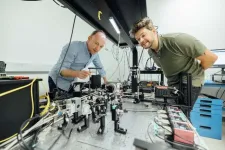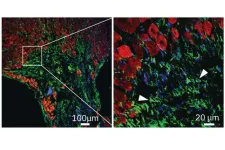(Press-News.org)
In 1181, a new star shone near the Cassiopeia constellation for six months before disappearing. This event, recorded as a “guest star” by Chinese and Japanese observers almost a millennium ago, has puzzled astronomers for centuries. It is one of a few supernovae to be documented before the invention of telescopes. In addition, it remained an “orphan” the longest, meaning that none of the celestial objects visible today could be assigned to it. Now known as the supernova SN 1181, its remnant has only been traced in 2021 to the nebula Pa 30, found in 2013 by amateur astronomer Dana Patchick while examining an archive of images from the WISE telescope as part of a citizen scientist project.
But this nebula is not a typical supernova remnant. In fact, astronomers were intrigued to find a surviving “zombie star” at its center, a remnant within the remnant. The 1181 supernova is thought to have occurred when a thermonuclear explosion was triggered on a dense, dead star called a white dwarf. Typically, the white dwarf would be completely destroyed in this type of explosion, but in this case, some of the star survived, leaving behind a sort of “zombie star.” This type of partial explosion is called a Type Iax supernova. Even more intriguingly, strange filaments emanated from this zombie star, resembling the petals of a dandelion flower. Now, ISTA Assistant Professor Ilaria Caiazzo and lead author Tim Cunningham, a NASA Hubble Fellow at the Center for Astrophysics, Harvard & Smithsonian, get an unprecedented close-up view of these strange filaments.
A 3D model of a ballistically expanding explosion
The team around Cunningham and Caiazzo could study this strange supernova remnant in detail thanks to Caltech’s Keck Cosmic Web Imager (KCWI). KCWI is a spectrograph located above 4,000 meters at the W. M. Keck Observatory in Hawaii, near the summit of Mauna Kea volcano, Hawaii’s highest peak.
As its name indicates, KCWI was designed to detect some of the faintest and darkest sources of light in the universe, collectively called the “cosmic web”. In addition, KCWI is so sensitive and smartly designed that it can capture spectral information for every pixel in an image. It can also measure the motion of matter in a stellar explosion, creating something like a 3D movie of a supernova. KCWI does so by examining how the light shifts while moving closer to or away from us, a physical process similar to the familiar Doppler shift we know from blaring sirens that change their tune as an ambulance races by.
Thus, instead of only seeing the typical static image of a fireworks display common to observations of supernovae, the researchers could create a detailed 3D map of the nebula and its strange filaments. In addition, they could show that the material in the filaments traveled ballistically at approximately 1,000 kilometers per second. “This means that the ejected material has not been slowed down, or sped up, since the explosion,” says Cunningham. “Thus, from the measured velocities, looking back in time allowed us to pinpoint the explosion to almost exactly the year 1181.”
Evidence of an unusual asymmetry
Beyond the dandelion-shaped filaments and their ballistic expansion, the overall shape of the supernova is most unusual. The team could demonstrate that the ejecta—the material within the filaments being ejected away from the explosion site—is unusually asymmetrical. This suggests that the asymmetry stems from the initial explosion itself. Also, the filaments appear to have a sharp inner edge, showing an inner “gap” surrounding the zombie star. “Our first detailed 3D characterization of the velocity and spatial structure of a supernova remnant tells us a lot about a unique cosmic event that our ancestors observed centuries ago. But it also raises new questions and sets new challenges for astronomers to tackle next,” concludes Caiazzo. She started working on this project as a Burke-Sherman Fairchild Postdoctoral Fellow in theoretical astrophysics at Caltech, USA, before joining ISTA in May this year.
***
About ISTA
The Institute of Science and Technology Austria (ISTA) is a PhD-granting research institution located in Klosterneuburg, 18 km from the center of Vienna, Austria. ISTA employs professors on a tenure-track model, post-doctoral researchers and PhD students. The Graduate School of ISTA offers fully funded PhD positions to highly qualified candidates with a Bachelor’s or Master’s degree in biology, mathematics, computer science, physics, chemistry, and related areas. While dedicated to the principle of curiosity-driven research, ISTA aims to deliver scientific findings to society through technological transfer and science education. President of the Institute is Martin Hetzer, a renowned molecular biologist and former Senior Vice President at The Salk Institute for Biological Studies in California, USA.
www.ista.ac.at
END
Clinics that offer exosome therapies claim they have the ability to repair and regenerate tissues and treat inflammatory and other immune-related conditions in a noninvasive way. Now, a team of bioethicists and legal scholars from Japan is sounding the alarm on the urgent need for stronger regulations surrounding these unproven interventions. Their letter appears October 24 in the journal Stem Cell Reports.
“Administering these treatments to patients without scientific evidence or a clear ...
When early cartographers undertook perilous expeditions to map unknown corners of the world with sextants, compasses, and hand-drawn diagrams, it’s unlikely they imagined that someday anyone with an internet connection would have access to a seamless view of the entire planet from the comfort of their own home. Today, pioneering scientists are working to create a similar experience for a much tinier, but no less important domain: developing embryos. The goal is to track and map the behavior of each and every cell working together to create an adult lifeform, and present that map in a clickable, ...
Using a few zaps of electricity to the skin, researchers can stop bacterial infections without using any drugs. For the first time, researchers designed a skin patch that uses imperceptible electric currents to control microbes. The results appear October 24 in the Cell Press journal Device.
“This opens up exciting possibilities for drug-free treatments, especially for skin infections and wound healing, where antibiotic-resistant bacteria pose a serious challenge,” says University of Chicago’s Bozhi Tian, one of the paper’s ...
About The Study: These interim findings demonstrate the feasibility of targeted interpretation of a predefined set of genes from genome sequencing in a population of different racial and ethnic groups. DNA sequencing offers an additional method to improve screening for conditions already included in newborn screening and to add those that cannot be readily screened because there is no biomarker currently detectable in dried blood spots. Additional studies are required to understand if these findings are generalizable to populations of different racial and ethnic groups and ...
Early results from a study of newborn screening methods show that DNA analysis picks up many more preventable or treatable serious health conditions than standard newborn screening and is favored by most parents who are offered the option.
The study—called GUARDIAN—is one of the first large-scale studies in the world to use genome sequencing as a method for newborn screening and is the first to publish preliminary results.
“The results show us that genome sequencing can radically improve children’s medical care,” says Joshua Milner, professor of Pediatrics, director of Allergy/Immunology and Rheumatology ...
About The Study: In this cohort study, non-Hispanic Black race was associated with increased odds of not receiving guideline-concordant care (GCC) and less timely treatment initiation. Non-Hispanic Black race was associated with increased all-cause mortality, which was reduced after adjusting for GCC and clinical and sociodemographic factors. These findings suggest that optimizing timely receipt of GCC may represent a modifiable pathway to improving inferior survival outcomes among older non-Hispanic Black ...
About The Study: This cross-sectional study found that absolute concentrations of fentanyl, methamphetamine, and cocaine in urine specimens increased from 2013 to 2023, with a decrease in heroin concentration during that period. The findings suggest that exposure to these substances, as well as the illicit drug supply, has fundamentally changed in many parts of the U.S., highlighting the need to reinforce surveillance initiatives and accelerate efforts to treat individuals with illicitly manufactured fentanyl and/or stimulant exposure.
Corresponding Author: To ...
Scientists at the Eli and Edythe Broad Center of Regenerative Medicine and Stem Cell Research at UCLA have developed a first-of-its-kind experimental therapy that has the potential to enhance heart repair following a heart attack, preventing the onset of heart failure.
Cardiovascular disease continues to be the world’s leading cause of death, contributing to one-third of deaths annually. After a heart attack, the heart’s innate ability to regenerate is limited, causing the muscle to develop scars to maintain its structural integrity. ...
HOUSTON ― Researchers from The University of Texas MD Anderson Cancer Center demonstrated that anti-PD-L1 immunotherapy in combination with mutation-directed targeted therapy extended overall survival (OS) in patients with anaplastic thyroid carcinoma (ATC). Findings from the Phase II single center study published today in JAMA Oncology.
The trial enrolled 42 patients across three cohorts to evaluate mutation-matched targeted therapy and the immune checkpoint inhibitor atezolizumab. The median OS across all cohorts was 19 months, which compares favorably to historical OS of five months for patients with ATC. ...
Producing materials such as steel, plastics and cement in the United States alone inflicts $79 billion a year in climate-related damage around the world, according to a new study by engineers and economists at the University of California, Davis. Accounting for these costs in market prices could encourage progress toward climate-friendly alternatives.
“We wanted to look at the cost to society to produce these materials,” said Elisabeth Van Roijen, a recent Ph.D. graduate from the UC Davis Department of Civil and Environmental Engineering ...





